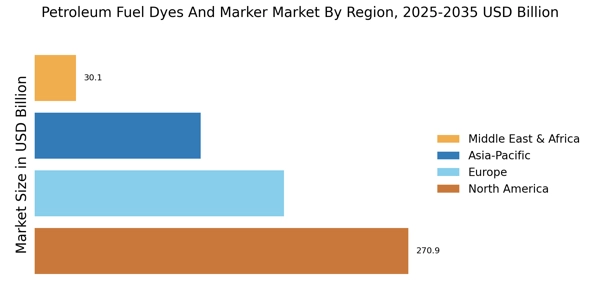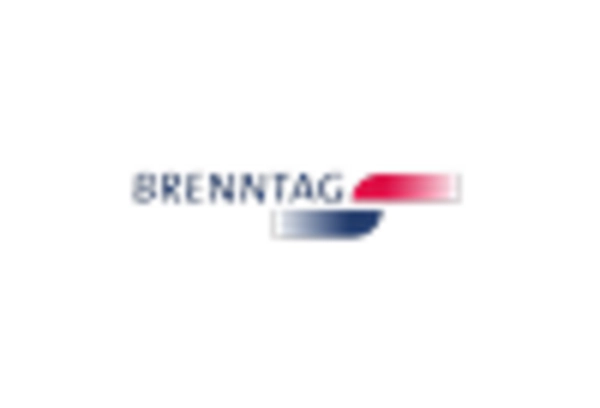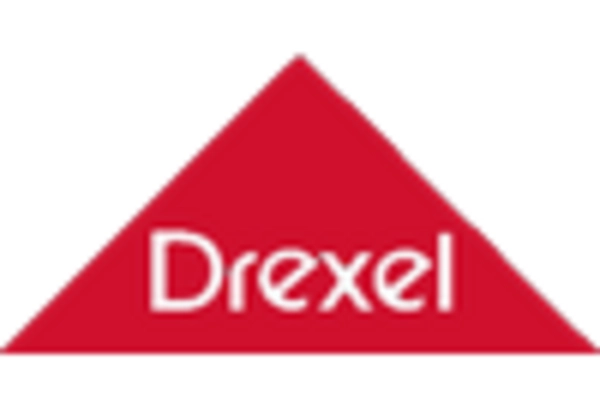Shift Towards Sustainable Solutions
The shift towards sustainable solutions is a pivotal driver in the Petroleum Fuel Dyes And Marker Market. As industries and consumers alike become more environmentally conscious, there is a growing preference for dyes that are biodegradable and derived from renewable resources. This trend is not only aligned with global sustainability goals but also encourages manufacturers to innovate and reformulate their products. The increasing availability of bio-based dyes is likely to reshape market dynamics, as companies strive to meet consumer expectations and regulatory requirements. Furthermore, the market for sustainable petroleum fuel dyes is anticipated to expand, with estimates suggesting a growth trajectory of approximately 7% over the next few years, reflecting the industry's commitment to environmental stewardship.
Rising Demand for Fuel Marking Solutions
The rising demand for fuel marking solutions is a critical factor propelling the Petroleum Fuel Dyes And Marker Market. As fuel prices fluctuate and competition intensifies, fuel distributors are increasingly adopting marking solutions to differentiate their products and ensure compliance with local regulations. This trend is particularly evident in regions where fuel smuggling and tax evasion are prevalent, prompting authorities to enforce stricter identification measures. The market for fuel marking dyes is projected to grow significantly, with estimates indicating a potential increase of around 8% in the next few years. This growth is driven by the need for enhanced security and traceability in fuel distribution, thereby solidifying the role of petroleum fuel dyes in the industry.
Technological Advancements in Dye Formulation
Technological advancements in dye formulation are significantly influencing the Petroleum Fuel Dyes And Marker Market. Innovations in chemical engineering and material science have led to the development of more efficient and durable dyes that offer enhanced performance characteristics. These advancements not only improve the visibility and stability of dyes in various fuel types but also reduce the environmental impact associated with their production and application. The introduction of advanced formulations that are resistant to fading and degradation is likely to attract a broader customer base, including fuel manufacturers and distributors. As a result, the market is expected to witness a steady increase in demand, with projections indicating a potential growth rate of around 6% in the coming years.
Expansion of the Automotive and Aviation Sectors
The expansion of the automotive and aviation sectors is contributing to the growth of the Petroleum Fuel Dyes And Marker Market. As these sectors continue to evolve, the demand for high-quality fuels that meet specific performance standards is increasing. Consequently, the use of dyes and markers to ensure fuel quality and compliance with industry regulations is becoming more prevalent. The automotive industry, in particular, is witnessing a surge in the use of specialized fuels, which necessitates the incorporation of dyes for identification and quality assurance. Projections suggest that the market for petroleum fuel dyes could experience a growth rate of approximately 5% as these sectors expand, highlighting the interconnectedness of fuel quality and industry growth.
Regulatory Compliance and Environmental Awareness
The Petroleum Fuel Dyes And Marker Market is experiencing a notable surge in demand due to increasing regulatory compliance and heightened environmental awareness. Governments across various regions are implementing stringent regulations to ensure the proper identification of fuels, which necessitates the use of dyes and markers. This regulatory landscape not only promotes transparency in fuel distribution but also aids in the prevention of tax evasion and illegal fuel usage. As a result, the market for petroleum fuel dyes is projected to grow, with estimates suggesting a compound annual growth rate of approximately 5% over the next few years. The emphasis on environmental sustainability further drives the adoption of eco-friendly dyes, thereby reshaping the Petroleum Fuel Dyes And Marker Market.


















Leave a Comment